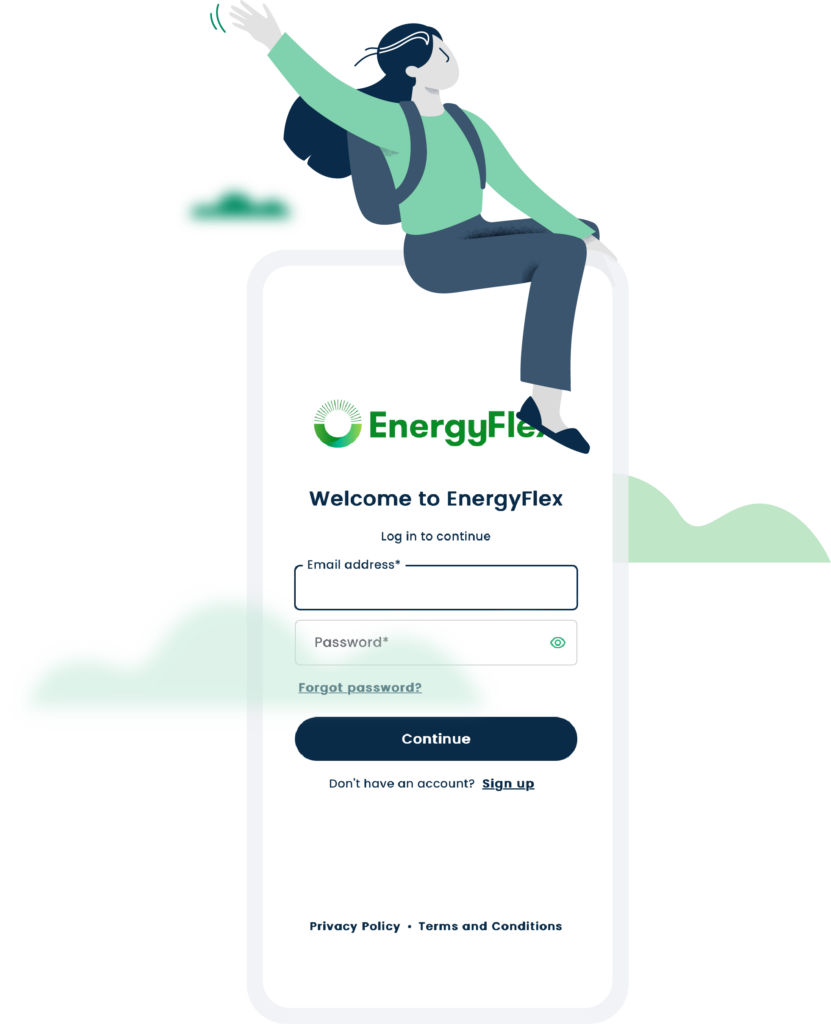When the energy grid was mainly powered by fossil fuels, electricity was cheap, reliable, and energy bills were relatively stable. Peak and off-peak times and tariffs were predictable: electricity was expensive when demand was the highest in daytime, and cheap overnight when demand was low.
But as more renewable energy sources are added to the mix, and as fossil fuel power plants are retired, the lines between peak and off-peak times and tariffs are becoming increasingly blurred.
The changing make-up of the energy grid, coupled with the legacy of our energy consumption patterns, could lead to grid instability and fluctuating energy bills.
Now, prices are highest at night when the sun isn’t shining, and the wind isn’t blowing, and they stay high even if demand is low. Prices drop drastically during the day – even if demand is high – when wind and solar generation peaks.
The result? What we traditionally think of as the “peak period” (from 7am till 9pm) can contain both the lowest and highest prices.
But while some things change (like the energy system), others stay the same (like how we use and are charged for electricity). This mismatch results in grid instability and ever-increasing energy bills.
The good news is that if we learn how the energy system works, electricity can become cheap and reliable again if we just change how and when we use it. And it starts with understanding your energy tariff. By understanding and adjusting your energy usage to align with renewable generation times, you can optimise your energy costs while also minimising emissions.
What is an energy tariff?
An energy tariff is the way you buy electricity.
Just like you pay a certain amount for a litre of petrol, you also pay a certain amount for a kilowatt hour (kWh) of electricity. And just like the price of petrol changes throughout the day, so too does the wholesale price of electricity (every five minutes, to be exact).
Energy retailers turn the varying wholesale price into a set of pricing plans (tariffs) for you to choose from. The trick is choosing the right one, and that largely depends on your consumption habits and how flexible you can be with your usage.
In Australia there are five common tariff structures: Flat rate tariff, time-of-use tariff, controlled load tariff, demand tariff and wholesale tariffs.
 The age-old flat tariff
The age-old flat tariff
With a flat rate (or single tariff), you pay the same price for electricity, no matter what time of the day you use it.
Whether you’re blasting your AC at midday or watching Netflix at midnight, you pay the same rate for every kWh you use. This is the traditional way to buy electricity.
Flat tariffs were appropriate when electricity was cheap, reliable, and prices were stable. Now that electricity is expensive, prices are volatile, and supply cannot always be guaranteed, flat tariffs will become increasingly unaffordable.
A flat rate is a good option to practice becoming Renewables Ready without risking higher prices. If you can be flexible with your energy use and shift most of your consumption into renewable generation periods, you could reduce your bills and carbon emissions by switching to a time-of-use tariff.
But how will you know? By using EnergyFlex, which shows you how much money and emissions you could have saved if you were on a different energy plan. It also teaches you how to shift your energy usage for even more savings.
- Pros: Straightforward and predictable.
- Cons: Will become the most expensive way to buy electricity. Does not allow for potential savings during off-peak times.
- Good to know: If you don’t have a smart meter, you will pay a flat rate for electricity. That’s because older meters cannot support flexible tariff structures.
Time-of-use tariff: Adapting to renewables
With a time-of-use tariff (or variable rate), you pay different rates for electricity depending on the time of day that you use it.
Time-of-use tariffs set different rates for different blocks of time. A standard setting is for “peak” rates between 7am and 9pm on weekdays, with “off-peak” rates for all other times, but these could differ between retailers. Some retailers include a “shoulder” tariff for the period between peak and off-peak rates.
We suggest checking your energy contract to understand how your time-of-use tariff is constructed. Adjust your electricity use to match the timings and gain more control over your bill.
Just like the flat tariff, a set time-of-use tariff will allow you to practice becoming flexible in your electricity use to achieve a better cost and carbon outcome. As you learn how to adjust, you can move to a new time-of-use tariff that allows you to improve your EnergyFlex Rating, reducing your cost and carbon as you go.
- Pros: You can save money and carbon emissions if you shift your usage to off-peak times.
- Cons: Energy costs more during peak times, so you need to be mindful of when you use it.
- Good to know: You need a smart meter to access variable rates.
Controlled load tariff: The appliance-specific approach
With a controlled load tariff, you pay a separate cheaper rate for specific, high-energy appliances, like your hot water heater or pool pump. These appliances are hard wired and controlled by the distributor, who can use your appliance to help balance electricity supply.
- Pros: Controlled load rates are lower than flat and peak time-of-use rates with dedicated savings for high-energy appliances.
- Cons: Only benefits some appliances.
- Good to know: You need a dedicated smart meter to access controlled load rates, and you’ll need an electrician to install a controlled load appliance.
Demand tariff: Speed matters
With a demand tariff, you’re charged based on the speed (rate) at which you use power, not the total amount used (kW instead of kWh).
Picture it as the speed of filling a bucket with a hose (rate) versus how much water the bucket can hold (volume). The faster the water comes out of the hose, the more you’ll pay. If you turn down the pressure, you’ll pay less for the same amount of water.
Common types of demand tariffs include ‘peak demand‘, which charges for the highest usage rate in a specific peak time (which may not be the same peak period as a time-of-use plan), and ‘anytime peak‘, which charges for the highest usage rate throughout an entire period.
Demand charges were bundled into flat tariffs because the old meters could not measure them. But with smart meters, demand tariffs are more visible. And because you can see your demand, you can better control it and pay less than community averages.
The moral of the demand tariff story is: Don’t use multiple energy-intensive appliances at the same time. If you’re going to use the oven, turn off the air conditioning.
- Pros: Visibility allows you to manage your bills.
- Cons: Discipline is required. You could pay more if you ignore the demand charge.
- Good to know: You need a smart meter to access demand tariffs.
Wholesale tariffs: The backbone of retail prices
Wholesale tariffs (also known as ‘spot exposed tariffs’) are based on the ‘spot price’, which is the price that energy companies pay when they buy your electricity from the National Electricity Market (NEM).
The spot price in the NEM is set every five minutes by the Australian Energy Market Operator (AEMO) based on many factors, like long-term planning and the amount of electricity available at a given moment.
This price can vary from -$10 per kWh (usually when there is lots of renewable generation available) to $16.50 per kWh (if there’s a network problem or simply not enough generation to meet demand). Keep in mind, you usually pay $0.25 per kWh, so these fluctuations can become eye-watering. If you’re not cautious with your energy use, you could end up paying a lot more than you expected.
Energy retailers make complicated deals to manage the ups and downs of these prices. Then they offer you a set price for electricity. Essentially, they are insuring you against the risk of price volatility, and they are charging you a premium for this service. If you can manage the price risk of your electricity use, by maximising your EnergyFlex Rating for example, then you can save money through a wholesale tariff.
This may sound scary at first, but don’t worry: EnergyFlex can teach you how to confidently manage these risks on your own and progressively reduce the insurance premium you pay on your electricity use. Think of it like car insurance. You pay a set rate to avoid the risk of big, unpredictable costs. But as you get better at managing those risks (i.e., you become a more confident driver), you could opt for less coverage and a lower premium.
Pros: You pay the actual price for the electricity you use, and you can control your bill through your own actions. If you reduce your usage in the expensive times and increase your energy usage during the low-price times, you will reduce your electricity bill.
Cons: You will need to be very aware of your energy use to avoid high prices.
Good to know: Wholesale prices can be lower than flat rate and time-of-use tariffs, but they can also be much higher. If you switch to a wholesale tariff, you’ll need to be disciplined in how you use energy (by using more during the day and less at night, for example). You should also have a strategy to mitigate price risk (for example, the ability to reduce your usage when demand is high).
How do I know which tariff is best for me?
Before you can choose the best energy plan, you need to understand how and when you use energy, and where you can be flexible. This will help you decide which tariff is best for you.
If you have a smart meter, EnergyFlex can help you understand the full value and impact of your energy use and how much money you could save by changing electricity plans and/or shifting some of your use into periods when electricity is cleaner and cheaper.
Remember, becoming Renewables Ready is not just about cost but also about environmental responsibility. By aligning with renewable generation periods, we’re not just saving on bills but also contributing to a greener planet.
Sign up for EnergyFlex here and we’ll guide you in negotiating a better rate with your retailer or if that fails, finding a better plan for you.





